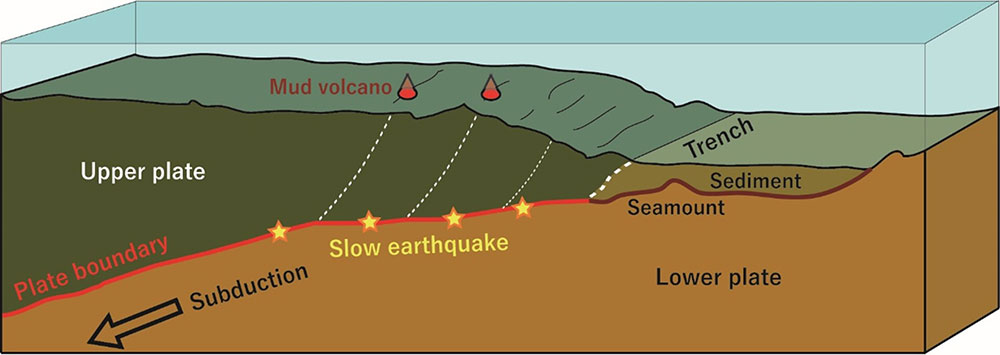Press Releases




JAMSTEC
Earthquake Research Institute,
The University of Tokyo
Kochi University
Atmosphere and Ocean Research Institute,
The University of Tokyo
Discovery of fluid conduits that extend from the plate boundary fault hosting slow earthquakes to the seafloor
―Successful imaging of the upper-plate fracture zones formed by a subducting ridge―
1. Key Points
- ◆
- Fluid behavior at plate boundaries is thought to impact the occurrence of earthquakes and the formation of mud volcanos (*1). However, there are limited data supporting the fluid-related upper-plate structures, and the physical properties at the source faults of slow earthquakes (*2) are not fully understood.
- ◆
- The analysis of seismic survey data obtained at Hyuganada led to the discovery of low-velocity bodies several kilometers wide that extend vertically from the seafloor to the plate boundary in the upper plate. These low-velocity bodies are likely fracture zones formed by the subduction of the Kyushu–Palau Ridge, and they were found to be linked to the fluid-rich regions hosting slow earthquakes.
- ◆
- The discovered fracture zones serve as conduits for the fluids ascending from the plate boundary, some of which may form mud volcanoes on the seafloor that serve as outlets for the fluids.
- ◆
- Together with the analysis of the surrounding seismic data, the findings of this study are expected to advance the understanding of the fluid circulation in plate subduction zones and the mechanisms of megathrust and slow earthquakes in the future, contributing to disaster prevention and mitigation against earthquakes and tsunamis that occur in sea areas.
【Supplementary Information】
- *1.
- Mud volcanoes: Landforms formed by the eruption of underground mud and rocks. Many mud volcanoes form conical landforms, and they are known to be distributed not only in volcanic areas but also in plate subduction zones. Mud volcanoes are mainly formed when fluids generated in the crust rise to the surface.
- *2.
- Slow earthquakes: A general term for earthquakes whose fault displacement is slower than that of normal earthquakes. Slow earthquakes are classified into different types according to the speed of displacement, and include low-frequency earthquakes, which are dominated by seismic wave components of several Hz; very-low-frequency earthquakes, which are dominated by components below 0.1 Hz; and slow slip events, in which a fault slips slowly over several days to several months or years without emitting seismic waves.
【Ref.】Conceptual diagram of a plate subduction zone

2. Overview
Researcher Ryuta Arai and colleagues of the Research Institute for Marine Geodynamics at the Japan Agency for Marine-Earth Science and Technology conducted seismic refraction (*3) and seismic reflection surveys (*4) in Hyuganada, located at the westernmost end of the Nankai Trough. Through the analysis of the seismic wave data, multiple vertical low-velocity bodies several kilometers wide that extend from the seafloor to the plate boundary (depth of 10–13 km) within the upper plate were discovered. These low-velocity bodies are likely areas where the upper plate is strongly fractured by the Kyushu–Palau Ridge (undulating seamounts) subducting from the southeast. These fracture zones were also found to be linked to the fluid-rich regions hosting slow earthquakes. The fracture zones in the upper plate serve as conduits for the fluids ascending from the deep crust, such as plate boundaries, and some of them are thought to form mud volcanoes on the seafloor.
Through detailed analysis of seismic wave data, this study revealed the complex crustal structure within the upper plate and around the plate boundary formed by the subduction of the Kyushu–Palau Ridge. These findings will be important for understanding the fluid circulation in plate subduction zones and the mechanisms of megathrust and slow earthquakes.
This study was supported by Grants-in-Aid for Scientific Research from the Japan Society for the Promotion of Science (project numbers: 16H06475, 19H04629, 21H05202, 22K03789). The findings of this study will be published in the British scientific journal “Nature Communications” on September 20 (Japan time).
- Research Institute for Marine Geodynamics, JAMSTEC
- Earthquake Research Institute, The University of Tokyo
- Lawrence Berkeley National Laboratory
- Kochi Institute for Core Sample Research, JAMSTEC
- Graduate School of Environmental Studies, Nagoya University
- Atmosphere and Ocean Research Institute, The University of Tokyo
【Supplementary Information】
- *3.
- Seismic refraction survey: In a seismic refraction survey in sea areas, acoustic waves are emitted into the sea from an air gun towed near the sea surface, and the acoustic waves, as well as seismic waves refracted from below the seafloor, are recorded by ocean bottom seismographs deployed at regular intervals on the seafloor. Using the recorded seismic waves, the P-wave velocity below the seafloor is estimated from the waveform information, including the propagation time of the P-wave (initial wave), which reaches the ocean bottom seismographs earliest, and subsequent waves.
- *4.
- Seismic reflection survey: In a seismic reflection survey in sea areas, acoustic waves are emitted into the sea from an air gun towed near the sea surface, and streamer cables equipped with hydrophones are used to capture waves that return to near the surface after being reflected at boundary surfaces below the seafloor where velocity and density change. Geological structure below the seafloor can be revealed by processing and analyzing the arrival time and amplitude of the captured reflected waves.
Contacts
- For this study
- Researcher Ryuta Arai
Research Institute for Marine Geodynamics (IMG) Subduction Dynamics Research Center (SDR) Marine Seismology Research Group, JAMSTEC - Professor Kimihiro Mochizuki
Earthquake Research Institute, The University of Tokyo
Earthquake Prediction Research Center - Professor Yoshitaka Hashimoto
Science and Technology Unit, Natural Sciences Cluster, Kochi University - Professor OKINO Kyoko
Department of Ocean Floor Geoscience Atmosphere and Ocean Research Institute,
The University of Tokyo
- For press release
- Press Office, Marine Science and Technology Strategy Department, JAMSTEC
Earthquake Research Institute, The University of Tokyo
The University of Tokyo
Public Relations Office, Kochi University